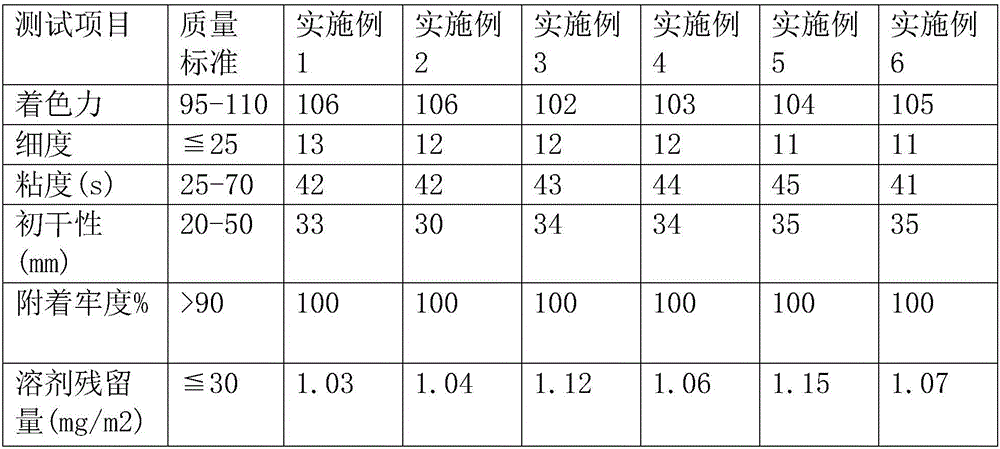Multifunctional aqueous printing ink
A water-based ink, multi-functional technology, applied in the direction of ink, household appliances, applications, etc., can solve the problems of ink deterioration, production equipment pollution, pollution and other problems
- Summary
- Abstract
- Description
- Claims
- Application Information
AI Technical Summary
Problems solved by technology
Method used
Image
Examples
preparation example Construction
[0022] Preparation of Waterborne Polyurethane Binder
[0023] (1) Raw material pretreatment: first, polyadipate sebacate neopentyl glycol-1,4-butanediol ester diol was decompressed and dehydrated for 1.5h at 85°C and 0.1MPa vacuum, and the The number-average molecular weight of polyadipate sebacate neopentyl glycol-1,4-butanediol ester diol is 2000, and 4,4'-dicyclohexylmethane diisocyanate is dehydrated and dried with activated molecular sieves;
[0024] (2) Preparation of prepolymer: 35 parts by weight of polyadipate sebacate neopentyl glycol-1,4-butanediol ester diol is added in the flask, and the flask is equipped with a stirrer and a condenser , a thermometer and a ventilation tube, feed dry argon into the reaction system, then start the agitator, add 30 parts by weight of diethylenetriamine, then add 5 parts by weight of 4,4'-dicyclohexylmethane diisocyanate and 0.02 parts by weight of bismuth naphthenate, slowly warming up to 75°C, and reacting at a constant temperatur...
Embodiment 1
[0029] 35 parts by weight of waterborne polyurethane;
[0030] 10 parts by weight of polyethylene emulsion;
[0031] 1 part by weight of polyamide wax;
[0032] 0.5 parts by weight of polymethacrylate-styrene copolymer;
[0033] 0.2 parts by weight of hydroxymethylcellulose;
[0034] 0.2 parts by weight of potassium oleate;
[0035] 0.2 parts by weight of 2,6-di-tert-butyl-4-methylphenol;
[0036] 0.5 parts by weight of sodium alkylsulfonate;
[0037] 10 parts by weight of pigment;
[0038] 15 parts by weight of water;
[0039] 5 parts by weight of ethyl acetate;
[0040] 0.3 parts by weight of oregano oil;
[0041] 0.2 parts by weight of Claria essential oil;
[0042] 0.2 parts by weight of tea tree essential oil.
Embodiment 2
[0044] 40 parts by weight of waterborne polyurethane;
[0045] 20 parts by weight of polyethylene emulsion;
[0046] 3 parts by weight of polyamide wax;
[0047] 1 part by weight of polymethacrylate-styrene copolymer;
[0048] 1 weight part of hydroxymethyl cellulose;
[0049] 0.8 parts by weight of potassium oleate;
[0050] 0.6 parts by weight of 2,6-di-tert-butyl-4-methylphenol;
[0051] 1.5 parts by weight of sodium alkylsulfonate;
[0052] 20 parts by weight of pigment;
[0053] 25 parts by weight of water;
[0054] 20 parts by weight of ethyl acetate;
[0055] 0.5 parts by weight of oregano oil;
[0056] 0.4 parts by weight of Claria essential oil;
[0057] 0.3 parts by weight of tea tree essential oil.
PUM
 Login to View More
Login to View More Abstract
Description
Claims
Application Information
 Login to View More
Login to View More - R&D
- Intellectual Property
- Life Sciences
- Materials
- Tech Scout
- Unparalleled Data Quality
- Higher Quality Content
- 60% Fewer Hallucinations
Browse by: Latest US Patents, China's latest patents, Technical Efficacy Thesaurus, Application Domain, Technology Topic, Popular Technical Reports.
© 2025 PatSnap. All rights reserved.Legal|Privacy policy|Modern Slavery Act Transparency Statement|Sitemap|About US| Contact US: help@patsnap.com


